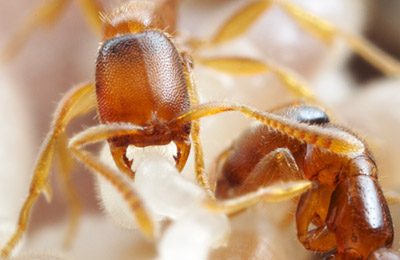Adetomyrma sp. "mad-01", larvae and adults
Madagascar
With a name like "dracula ant" you'd think these waspy little Adetomyrma might suddenly lunge for your jugular. But they are shy creatures, drinking not the blood of hapless victims but sparingly from the hemolymph of their own larvae. It's an odd behavior, yet one that makes a certain amount of sense when considering the haphazard way that evolution works.
Here's the problem: ants have a skinny little waist through which their digestive tract must pass. Solid food would lodge in the bottleneck and kill the ant, so the ants can't eat solids. They can only drink.
Yet, in forgoing solid food ants miss out on all sorts of protein available in the environment. Ants must either give up protein or figure out how to convert solids into drinkable juice. That's where the larvae come in.
Larvae are made to eat and can handle all manner of food. They consume the solids that the worker ants have brought back to the nest and, after a little digestion, pass the protein back as a liquid. Most ant species have a simple, elegant way to do this: they regurgitate for the adults when prompted. But this direct food-passing behavior only appears in the more recent ant lineages. The ancient subfamily Amblyoponinae- including Adetomyrma- diverged from the rest of the ants over 100 million years ago and couldn't inherit this sensible way of doing things.
Natural selection is a blind process. Evolution often solves problems with unexpected, rube-goldberg solutions that any reasonable designer would never implement, and the Amblyoponines happened on one of those odd solutions. They found a more morbid way to get at all those larval proteins. The adult ants just chew a hole in the larval skin. The hemolymph oozes out, and the adults take a drink.
It's a bit brutish, and the larvae bear scars, but it doesn't seem to cause long term harm. It's apparently just part of how larvae contribute back to the colony that feeds them.

In any case, a while back myrmecologist Brian Fisher loaned me a captive colony of his beloved Adetomyrma from Madagascar. These ants were first discovered less than 20 years ago- the species pictured here still lacks a formal scientific name- and the genus remains one of the rarest and least understood of all ants. It was a real treat to get my hands on such an oddity, and I've uploaded the new photos here:
postscript: If you'd like to see live Dracula Ants, there's no need to travel all the way to Madagascar. The centipede predator Amblyopone pallipes is widespread in North America and can be found in rotting wood and under stones in forested habitats.


Interesting.